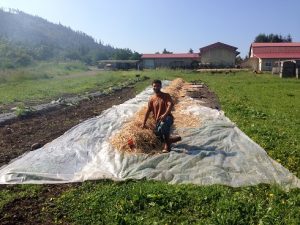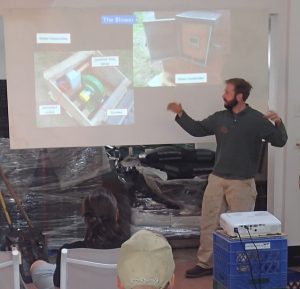 Here at Cloud Mountain, many hours have been dedicated to discussing how to improve the soils, and what improvement even means. By organic standards, the goal is to “manage plant and animal materials to maintain or improve soil organic matter content in a manner that does not contribute to contamination of crops…”. On way to improve organic matter content is to create and distribute compost around the farm. Yet with acres of vegetable production (not to mention land for the orchards), a lot of fertilizers are needed around the farm! So following in last year’s intern footsteps I have led this year’s production of the compost pile. Like last year the compost pile is aerated with a timed blower, approximately 80 feet long, and comprised mostly of dairy waste solids.
Here at Cloud Mountain, many hours have been dedicated to discussing how to improve the soils, and what improvement even means. By organic standards, the goal is to “manage plant and animal materials to maintain or improve soil organic matter content in a manner that does not contribute to contamination of crops…”. On way to improve organic matter content is to create and distribute compost around the farm. Yet with acres of vegetable production (not to mention land for the orchards), a lot of fertilizers are needed around the farm! So following in last year’s intern footsteps I have led this year’s production of the compost pile. Like last year the compost pile is aerated with a timed blower, approximately 80 feet long, and comprised mostly of dairy waste solids.
The first step in creating the pile is to prepare the area. Since weed pressure around the pile is a concern, I have laid out a patchwork quilt of old greenhouse plastic, and salvageable bits from last year’s project. Though the hoop house coverings may not be useful for their original purposes, reusing what one can is another step toward sustainability.
In the background of the picture, is a straw covered pipe. The pipe will force air through the composting pile. Just like a fire needs to be fanned, so does the multitude of microbes which convert the waste into the nutrient-rich fertilizer desired. As the tiny activities speed up, the pile begins to heat up further fueling the process. Check back here for more updates to how this process will develop. With a little luck, a bit of patience, and a splash of water, the empty area behind will fill up with rich compost.
*** Update ***
The project to turn local dairy waste into nutritious fertilizer is steaming ahead! The compost pile has reached 145 degrees Fahrenheit and maintained that temperature for more than two weeks. This is hot enough to enter into the Process for Further Reducing Pathogen (PFRP) stage. At this stage, most of the undesired pathogens existing in raw manure are killed off by heat, while other microbes thrive and create a more stable mound of fertilizer. While millions upon millions of microbes are busy inside the pile, Cloud Mountain former intern, Chris Henderson (whom has lent invaluable support on this project) and Washington State University Department of Crop and Soil Sciences researcher Andy Bary held a workshop helping farmers learn about the aerated static pile composting system. The Aerated Static Pile is one which forced air is blown through the compost pile to provide the oxygen that aerobic microbes need to convert the waste into nutrient-rich compost. The Aerated Static Pile enables better nutrient retention and saves energy and time by eliminating the need to ‘turn’ the pile.
The workshop was a great chance for about a dozen local farmers to learn how to reduce methane, offensive odors and nutrient loss through an affordable and simple system. At the moment the compost pile is slowly cooling down, and a new batch of microbes will continue to recolonize the freshly processed fertilizer. Once cooled down to ambient temperatures, the compost will mature in preparation for fall spreading.
For questions about the composting equipment available through the Farm Fund grant, contact Chris Henderson at: hende107@gmail.com


